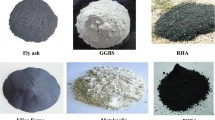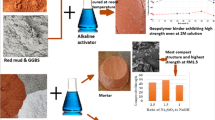Abstract
The effect of silicate content (SiO2/Na2O) of an activator on physical and mechanical properties of alkali-activated blast furnace slag paste has been investigated. The paste was produced by activating blast furnace slag with sodium silicate (Na2SiO3) and sodium hydroxide (NaOH) solution. The SiO2/Na2O ratio varied from 0.2 to 1.2. The test specimens were cast and cured in water (fully immersed condition) at room temperature and the direct compressive strength at the age of 3, 7, 14, 21, 28 days were obtained. It has been observed that the compressive strength and ultrasonic pulse velocity of test specimen increases with the increase in silicate content up to a silicate ratio of 0.8. Compressive strength is found to be a maximum 44.53 MPa at 28 days. It is noticed further that the compressive strength increases with age. It is also observed that the silicate ratio has a significant influence on porosity, water absorption and water sorptivity. The mineralogical and micro-structural changes were studied using XRD and SEM/EDX, while porosity, total pore volume, pore-size distribution, etc., were studied using mercury intrusion porosimetry.

Similar content being viewed by others
References
Davidovits J.: 5th Global warming international conference, global warming impact on the cement and aggregates industries. World Resour. Rev. 6, 263–278 (1994)
Wang S.D., Pu X.C., Scrivener K.L., Pratt P.L.: Alkali-activated slag cement and concrete: a review of properties and problems. Adv. Cement Res. 27, 93–102 (1995)
Yang K.H., Song J.K., Ashour A.F., Lee E.T.: Properties of cementless mortars activated by sodium silicate. Construct. Build. Mater. 22(9), 1981–1989 (2008)
ACI-116R, Cement and Concrete Terminology. Reported by ACI Committee 116. American Concrete Institute (2000)
Shi, C.; Krivenko, P.V. and Roy, D.: Alkali-Activated Cements and Concrete. Taylor and Francis, Abingdon (2006)
Niu, Q; Feng, N.; Yang; J.ve Zheng, X.: Effect of superfine slag powder on cement properties. Cement Concrete Res. 32(4), 615–621 (2002)
Bakharev T., Sanjayan J.G., Cheng Y.B.: Alkali activation of Australian slag cement. Cement Concrete Res. 29(1), 113–120 (1999)
Brough A.R., Atkinson A.: Sodium silicate based, alkali activated slag mortars: Part 1 Strength, hydration and microstructure. Cement Concrete Res. 32(6), 865–879 (2002)
Roy D.M.: Alkali activated cements: opportunities and challenges. Cement Concrete Res. 29, 249–54 (1999)
Krivenko, P.D.: Alkaline cements and concrete. Paper presented at the first International conference in Kiev, Ukraine (1994)
Jiang, W.: Alkali-activated cementitious materials: mechanisms, microstructure and properties, Ph.D. Thesis. The Pennslyvania State University, Pennsylvania (1997)
Taylor, H.F.W.: Cement Chemistry. Thomas Telford, London (1997)
Wang S.D., Scrivener K.L.: 29Si and 27Al NMR study of alkali activated slag. Cement Concrete Res. 33(5), 769–774 (2003)
Song S., Sohn D., Jennings H.M., Mason T.O.: Hydration of alkali activated ground granulated blast furnace slag. J. Mater. Sci. 35, 249–257 (2000)
Qureshi M.N., Ghosh S.: Effect of alkali content on strength and microstructure of GGBFS paste. Global J. Res. Eng. 13(1), 11–19 (2013)
Chen W., Brouwers H.: The hydration of slag part 1: reaction models for alkali-activated slag. J. Mater. Sci. 42(2), 428–443 (2007)
Krizan D., Zivanovic B.: Effects of dosage and modulus of water glass on early hydration of alkali-slag cements. Cement Concrete Res. 32(8), 1181–1188 (2002)
Wang S.D., Scrivener K.L., Pratt P.L.: Factors affecting the strength of alkali activated slag. Cement Concrete Res. 24(6), 1033–1043 (1994)
Xu H., Van Deventer J.S.J.: The geo-polymerisation of alumino-silicate minerals. Int. J. Miner. Process. 59, 247–66 (2000)
Palomo A., Grutzeck M.W., Blanco M.T.: Alkali-activated fly ashes, a cement for the future. Cement Concrete Res. 29, 1323–1329 (1999)
Bondar D., Lynsdale C.J., Milestone N.B., Hassani N., Ramezanianpour A.A.: Effect of type, form, and dosage of activators on strength of alkali-activated natural pozzolans. Cement Concrete Res. 33(2), 251–260 (2011)
Cihangir F., Erç\({\imath}\)kd\({\imath}\) B., Kesimal A., Turan A., Deveci H.: Utilisation of alkali-activated blast furnace slag in paste backfill of high-sulphide mill tailings: Effect of binder type and dosage. Miner. Eng. 30, 33–43 (2012)
Bougara A., Lynsdale C., Ezziane K.: Activation of Algerian slag in mortars. Construct. Build. Mater. 23(1), 542–547 (2009)
Qureshi M.N., Ghosh S.: Effect of curing conditions on the compressive strength and microstructure of alkali-activated GGBS paste. Int. J. Eng. Sci. Invent. 2(2), 24–31 (2013)
Qureshi M.N., Ghosh S.: Effect of fineness on engineering properties of alkali-activated GGBFS paste. Int. J. Appl. Eng. Res. 8(2), 131–146 (2013)
Fernández-Jiménez A., Palomo J.G., Puertas F.: Alkali-activated slag mortars: mechanical strength behaviour. Cement Concrete Res. 29(8), 1313–1321 (1999)
Zhong B., Yang N.: Hydration characteristics of water glass-activated slag cement. Bull. Chin. Ceramic Soc. 23(6), 4–8 (1993)
Elahi, A.; Khan, Q.U.Z.; Barbhuiya, S.A.; Basheer, P.A.M.; Russell, M.I.: Hydration characteristics of cement paste containing supplementary cementitious materials. Arab. J. Sci. Eng. 37, 535–544 (2012)
Qureshi, M.N.; Ghosh S.: Workability and setting time of alkali activated blast furnace slag paste. ASTM Int. J. Adv. Civil Eng. Mater. 2(1) (2013). doi:10.1520/ACEM20120029
Hyung-Seok K., Joo-Won P., Yong-Jun A., Jong-Soo B., Choon H.: Activation of ground granulated blast furnace slag cement by calcined alunite. Mater. Transact. 52(2), 210–218 (2011)
ASTM C1437-07, Standard test method for flow of hydraulic cement mortar, ASTM Standards, ASTM International, West Conshohocken, pp 1–2 (2007)
ASTM C 230/C 230M −08, Standard specifications for flow table for use in tests of hydraulic cement, ASTM Standards, ASTM International, West Conshohocken, pp. 1–6 (2008)
ASTM C 1585-04: Standard test method for measurement of rate of absorption of water by hydraulic cement concretes. ASTM Standards, ASTM International, West Conshohocken, pp. 1–4 (2004)
IS: 13311 (Part 1). Indian standard non-destructive testing of concrete—methods of test. Part 1—ultrasonic pulse velocity. Bureau of Indian Standards, New Delhi, pp. 1–7 (1992)
Washburn, E.W.: The dynamics of fluid flow. Phys. Rev. 17(3), 2827–2833 (1921)
Sathonsaowaphak A., Chindaprasirt P., Pimraksa K.: Workability and strength of lignite bottom ash geopolymer mortar. J. Hazard. Mater. 168, 44–50 (2009)
Shi C., Li Y.: Investigation on some factors affecting the characteristics of alkali phosphorus slag cement. Cement Concrete Res. 19(4), 527–533 (1989)
Yu S., Wang W.: Hardening mechanism of clinker free sodium silicate slag cement. J. Chin. Silicate Soc. 18(2), 104–109 (1990)
Zhong B., Yang N.: Hydration characteristics of water glass-activated slag cement. Bull. Chin. Ceramic Soc. 23(6), 4–8 (1993)
Lu, P.: Origin and development of microstructure of alkali-BFS-SS paste. 2nd Beijing International Symposium on Cements and Concrete, Beijing, pp. 232–239 (1989)
Bondar D., Lynsdale C.J., Milestone N.B., Hassani N., Ramezanianpour A.A.: Effect of type, form, and dosage of activators on strength of alkali-activated natural pozzolans. Cement Concrete Res. 33(2), 251–260 (2011)
Cincotto, M.A.; Melo, A.A.; Repette, W.L.: Effect of different activators type and dosages and relation to autogenous shrinkage of activated blast furnace slag cement. In: Proceedings of the 11th International Congress on the Chemistry of Cement, Durban, pp. 1878–1887 (2003)
Astutiningsih, S.; Liu, Y.: Geopolymerisation of Australian slag with effective dissolution by the alkali. In: Davidovits, J. (ed.) Proceedings of the World Congress Geopolymer, Saint Quentin, pp. 69–73 (2005)
Adam, A.A.: Strength and durability properties of alkali activated slag and fly ash based geopoymer concrete, Ph.D. Thesis, RMIT University, Melbourne (2009)
Collins F., Sanjayan J.G.: Microcracking and strength development of alkali-activated slag concrete. Cement Concrete Res. 23, 345–352 (2001)
Atis C.D., Belim C., Celik O., Karahan O.: Influence of activator on the strength and drying shrinkage of alkali-activated slag mortar. Construct. Build. Mater. 23, 548–555 (2009)
Palacious M., Puertas F.: Effect of shrinkage-reducing admixtures on the properties of alkali-activated slag mortars and pastes. Cement Concrete Res. 37, 691–702 (2007)
Puertas F., Amat T., Fernandez-Jimenez A., Vazquez T.: Mechanical and durable behaviour of alkaline cement mortars reinforced with polypropylene fibres. Cement Concrete Res. 33, 2031–2036 (2003)
Winslow D.N., Diamond S.: A mercury porosimetry study of the evolution of porosity in Portland cement. J. Mater. 5((3), 564–585 (1970)
Arandigoyen M., Alvarez J.I.: Blended pastes of cement and lime: pore structure and capillary porosity. Appl. Surf. Sci. 252, 8077–8085 (2006)
Author information
Authors and Affiliations
Corresponding author
Rights and permissions
About this article
Cite this article
Qureshi, M.N., Ghosh, S. Effect of Silicate Content on the Properties of Alkali-Activated Blast Furnace Slag Paste. Arab J Sci Eng 39, 5905–5916 (2014). https://doi.org/10.1007/s13369-014-1172-x
Received:
Accepted:
Published:
Issue Date:
DOI: https://doi.org/10.1007/s13369-014-1172-x




